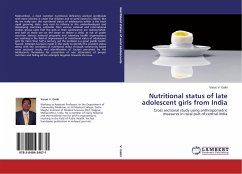
Social epidemiology of chronic Arsenicosis in India
Social determinants and consequences of chronic Arsenicosis due to consumption of arsenic contaminated groundwater
Versandkostenfrei!
Versandfertig in 6-10 Tagen
52,99 €
inkl. MwSt.

PAYBACK Punkte
26 °P sammeln!
Arsenic contamination of groundwater is a major public health problem in India. Essentially, the arsenic contamination occurred due to excessive usage of groundwater in agriculture that in turn has changed geological pattern and resulted in leaching of arsenic into aquifers. West Bengal is the worst affected state in the country. Millions of people have been suffering from various forms of adverse health manifestations due to drinking of contaminated water. There are numerous studies pertaining to clinical manifestations of chronic arsenicosis due to long-term intake of contaminated water. How...
Arsenic contamination of groundwater is a major public health problem in India. Essentially, the arsenic contamination occurred due to excessive usage of groundwater in agriculture that in turn has changed geological pattern and resulted in leaching of arsenic into aquifers. West Bengal is the worst affected state in the country. Millions of people have been suffering from various forms of adverse health manifestations due to drinking of contaminated water. There are numerous studies pertaining to clinical manifestations of chronic arsenicosis due to long-term intake of contaminated water. However, there are very few studies addressing social factors responsible for development of symptoms, impacts of symptoms on their live roles and complex dynamics of environmental, physical and social factors. The study showed that apart from magnitude of arsenic exposure; socioeconomic status, gender, malnutrition, access to health care played a major role in occurrence and distribution of chronic arsenicosis. Moreover, the consequences in the form of disability and handicap have also been determined by the aforementioned social factors.





![Evaluation of the Referral Transport System in [EMOC] Chandigarh India Cover Evaluation of the Referral Transport System in [EMOC] Chandigarh India](https://bilder.buecher.de/produkte/46/46988/46988156n.jpg)






